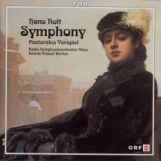Updated
on
January 4, 2025 |
 |
 |
 |
 |
 |
 |
 |
 |
 |
|
|
 |
 |
 |
 |
 |
 |
 |
| |
 |
|
| |
|
| Interpretively, Dennis Russell Davies's offering (CPO 999
854-2) opens a new chapter in the symphony's discography, playing
the score with the same no-nonsense directness and assurance
that he'd bring to the mainstream repertory. He teases motifs
from the textures for a fillip of contrapuntal interest, draws
the Sehr langsam in a single long, singing line, and gets good,
firm playing from the Vienna Radio forces (the horns' liquid
legato, security, and rhythmic point are a highlight. Too bad
he spoils the Finale - rather generalized in conception to
begin with - by reducing the cutting fanfares beginning at
15:57 to so much insensitive banging. I'd willingly have sacrificed
the fifteen-minute Pastorales Vorspiel - a nice bonus for collectors
- for a better finish. The sound is acceptable, although resonance
from the ubiquitous tympani muddies the textures, particularly
in the Scherzo, and the triangle has been given its head, perhaps
unwisely. |

Radio Symphonieorchester
Wien
Dennis Russell Davies
|
| At any rate, Davies's performance has been superseded by
a more recent release (Arte Nova 82876 57748 2), in which Sebastian
Weigle's handling of the score is no less surefooted and purposeful,
with the Munich Radio Orchestra offering beautiful, transparent
sonorities in the bargain (literally so, at Arte Nova prices).
The opening movement moves from a noble solitude (the trombone
solo at 4:17) through alienation and cautious optimism, to
a resolution of organlike majesty. The Sehr langsam flows easily,
without sacrificing either tonal weight or a sense of reverence;
the horns at 5:48 ff. lean on the hairpin dynamics mournfully,
and after 7:42 the conductor does a nice job of eliciting leading
voices normally buried within the brass choir. Pillowy, rather
than sharp-edged, brass attacks establish a buoyant forward
impulse for the Scherzo. If the solo violin in the first waltz
sounds a bit anemic, at least these episodes are straightforward,
with that at 7:38 turning vaguely spooky. The end of the movement
isn't particularly Wild, as requested, but the conductor once
again leads the ear by drawing important motifs out of the
busywork. After a strongly characterized, suspenseful introduction,
the Finale's main theme recalls the Brahms First in its striding
dignity; and, for once, the big half-cadence really sounds
poised to move on and resolve. And Weigle succeeds where Davies
fails in the coda, taking trouble to shape the climactic fanfares,
integrating the difficult ritards smoothly into the line; congestion
unfortunately remains a problem here as in other recordings
(though elsewhere the textures reproduce in wonderful three-dimensional
layers). Given the conductor's attention to finding motifs
buried within the brass, it's odd that he occasionally slights
the treble (melodic) voices in the tuttis. After the noisy
coda, though, the first of the two fillers - an Orchestervorspiel
in E - is balm to the ears, while the Julius Caesar
concert prelude, in its lively vigor and warm colors, is a throwback
to the Schumann/Weber era. |
|
| Part 6 |
|
Back to Part 4
|
|